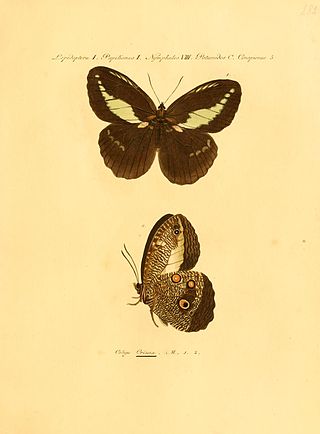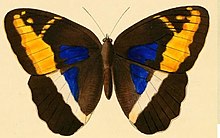
Danainae is a subfamily of the family Nymphalidae, the brush-footed butterflies. It includes the Daniadae, or milkweed butterflies, who lay their eggs on various milkweeds on which their larvae (caterpillars) feed, as well as the clearwing butterflies (Ithomiini), and the tellervini.

The Nymphalidae are the largest family of butterflies, with more than 6,000 species distributed throughout most of the world. Belonging to the superfamily Papilionoidea, they are usually medium-sized to large butterflies. Most species have a reduced pair of forelegs and many hold their colourful wings flat when resting. They are also called brush-footed butterflies or four-footed butterflies, because they are known to stand on only four legs while the other two are curled up; in some species, these forelegs have a brush-like set of hairs, which gives this family its other common name. Many species are brightly coloured and include popular species such as the emperors, monarch butterfly, admirals, tortoiseshells, and fritillaries. However, the under wings are, in contrast, often dull and in some species look remarkably like dead leaves, or are much paler, producing a cryptic effect that helps the butterflies blend into their surroundings.

The Satyrinae, the satyrines or satyrids, commonly known as the browns, are a subfamily of the Nymphalidae. They were formerly considered a distinct family, Satyridae. This group contains nearly half of the known diversity of brush-footed butterflies. The true number of the Satyrinae species is estimated to exceed 2,400.

Archaeoprepona demophon, the one-spotted prepona, banded king shoemaker, or demophon shoemaker is a butterfly belonging to the family Nymphalidae.

Agrias is a genus of Neotropical charaxine nymphalid butterflies found in South and Central America.

The Elymniini is one of the tribes of the subfamily Satyrinae. If the subfamily Satyrinae elevate to family status, this tribe shall be treated as subfamily Elymniinae. Elymniini was formerly a large group, but recently, it is considered to be include only one genus, Elymnias, according to molecular phylogenetic analyses.

The butterfly subtribe Euptychiina is a diverse group within the tribe Satyrini, occurring throughout Central and South America, in addition to a few species known from North America. Euptychiina is a predominantly lowland group, with the exception of one Asian taxon Palaeonympha opalinaButler, 1871 and the Andean genus ForsterinariaGray, 1973. The taxon was erected by Lee Denmar Miller.

Brassolini is a tribe usually placed in the brush-footed butterfly subfamily Morphinae, which is often included in the Satyrinae as a tribe Morphini. If this is accepted, the Brassolini become the sister tribe of the Morphini among the Satyrinae. Formerly, they were treated as an independent family Brassolidae or subfamily Brassolinae. Many members of this tribe are called owl butterflies.

Catonephele numilia, the blue-frosted banner, blue-frosted Catone, Grecian shoemaker or stoplight Catone, is a butterfly of the family Nymphalidae found in Central and South America.

Cithaerias andromeda, the Andromeda satyr, is a species of butterfly of the family Nymphalidae. It is found from Suriname, French Guiana, Venezuela, Peru, Bolivia and Brazil. Differentiation between subspecies and their corresponding sex is possible through variation in wing pattern as well as genitalia. The presence of brown bands in the hind wings of C. andromeda and a corpus bursae are common features in these female butterflies.

Doxocopa agathina, the agathina emperor, is a species of butterfly of the family Nymphalidae. It is found in the Guyanas, northern Brazil, and the Amazon region. It is also called the purple emperor but this name may also refer to the European butterfly Apatura iris.

Pronophilina is a Neotropical subtribe of butterflies of the subfamily Satyrinae. They are a species-rich group with highest diversity in the tropical and subtropical mountains, especially the Andes. Before 1970, they were poorly studied, but recent interest has resulted in high rates of species description from previously unexplored mountain ranges. However, there is still a lack of knowledge on their biology and ecology. Their relationship to other groups of Satyrine butterflies and their complex patterns of speciation within and among mountain ranges have led to several biogeographic discussions.

Dasyophthalma is a genus of medium-sized brownish butterflies in the family Nymphalidae. They are endemic to the Atlantic coastal region of Brazil. They feed on palms.

Dasyophthalma creusa is a butterfly of the family Nymphalidae. It is found in Brazil, from Bahia to Rio Grande do Sul.
Dasyophthalma vertebralis is a butterfly of the family Nymphalidae. It is found in Brazil. The habitat consists of forests.
Dasyophthalma geraensis is a butterfly of the family Nymphalidae. It is found in Brazil. The habitat consists of high elevation forests.

Ortilia liriope, the Brazilian crescent, is a butterfly of the family Nymphalidae. It was described by Pieter Cramer in 1775. It is found in French Guiana, Guyana, Suriname and northern Brazil.

Carla Maria Penz is a butterfly comparative morphologist and systematist, and the Doris Zemurray Stone Chair in Biodiversity at the University of New Orleans. Her research also focuses on natural history and behavior, mostly of neotropical butterflies.

Methona themisto, common name themisto amberwing, is a species of butterfly of the family Nymphalidae.

Napeocles jucunda, the great blue hookwing, is a South American butterfly of the family Nymphalidae. The species was first described by Jacob Hübner in 1808.


















